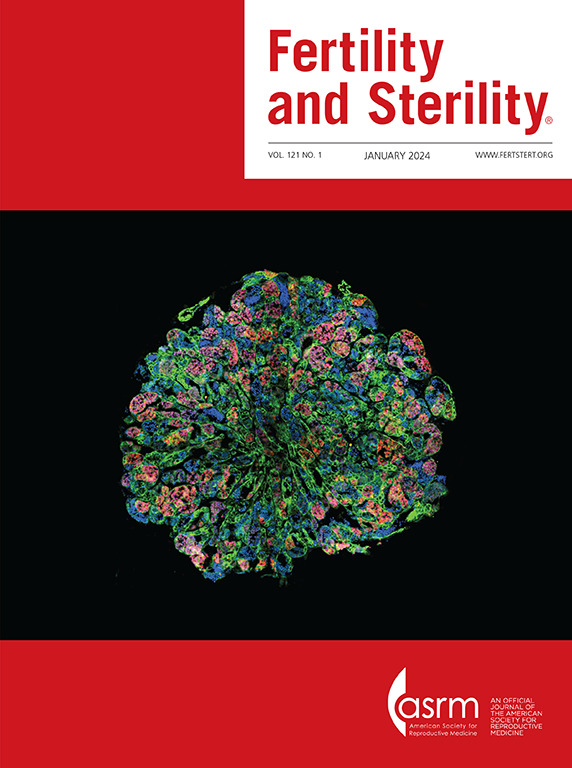癌症幸存者的无辅助妊娠率和结局:一项系统综述
IF 7
1区 医学
Q1 OBSTETRICS & GYNECOLOGY
引用次数: 0
摘要
本系统综述调查了癌症幸存者无辅助妊娠的结果。虽然先前的研究已经检查了癌症幸存者的妊娠结果,但明确无辅助妊娠的具体结果可以帮助指导患者和提供者的期望,并改善生育保留咨询。本系统综述的主要目的是确定癌症及其治疗对生育能力的影响,以无辅助妊娠的癌症幸存者的活产率(LBR)来衡量。次要目的包括确定癌症幸存者无辅助妊娠的父母和胎儿结局。我们检索了MEDLINE (PubMed)、Embase(爱思唯尔)、Cochrane Library (Wiley)和Scopus(爱思唯尔)从成立到2025年4月24日。在去重复后,1185条独特的引文由两名研究者进行盲法独立审查。全文筛选300份报告和64次引用。完成了43篇文章的主要终点活产率和次要终点的数据提取。本文章由计算机程序翻译,如有差异,请以英文原文为准。
Unassisted pregnancy rates and outcomes in cancer survivors: a systematic review
Importance
This systematic review investigates outcomes for unassisted pregnancies in cancer survivors. Although prior studies have examined pregnancy outcomes for cancer survivors, clarifying the outcomes specifically for unassisted pregnancies can help guide patient and provider expectations and improve fertility preservation counseling.
Objective
The primary objective of this systematic review was to identify the impacts of cancer and its treatment on fertility, measured as the live birth rate among cancer survivors with an unassisted pregnancy. Secondary objectives included identifying parental and fetal outcomes of unassisted pregnancies in cancer survivors.
Evidence Review
We searched MEDLINE (PubMed), Embase (Elsevier), Cochrane Library (Wiley), and Scopus (Elsevier) from inception through April 24, 2025. After de-duplication, 1,185 unique citations were subject to blinded independent review by two investigators. Full-text screening was performed on 300 reports and 64 secondary citations. Data extraction was completed for 43 articles for the primary outcome of live birth rates and secondary outcomes.
Findings
This review consolidates the available data on the outcomes of unassisted pregnancies in cancer survivors compared with individuals without cancer. Live birth rates were significantly lower in survivors of breast cancer and individuals who underwent hematopoietic stem cell transplant or abdominopelvic radiation therapy during their cancer treatment. Survivors of breast and gynecologic cancers had higher rates of pregnancy loss, although there were no differences in rates of hypertensive disorders of pregnancy, gestational diabetes, placental abnormalities, or cancer recurrence. Survivors exposed to radiation therapy were more likely to have infants who were small for gestational age or had low birth weight, and survivors of breast cancer were more likely to experience iatrogenic or spontaneous preterm birth. The effects of other types of cancers or treatments were not associated with significant differences in live birth rates or any secondary outcomes in included studies.
Conclusion and Relevance
Although unassisted pregnancy is possible for patients diagnosed with cancer, certain cancers and treatments are associated with decreased live birth rates and increased obstetric and neonatal complications. Individualized fertility preservation counseling throughout the cancer diagnosis and treatment process is an important aspect of comprehensive cancer care that helps patients make informed decisions about their future fertility.
求助全文
通过发布文献求助,成功后即可免费获取论文全文。
去求助
来源期刊

Fertility and sterility
医学-妇产科学
CiteScore
11.30
自引率
6.00%
发文量
1446
审稿时长
31 days
期刊介绍:
Fertility and Sterility® is an international journal for obstetricians, gynecologists, reproductive endocrinologists, urologists, basic scientists and others who treat and investigate problems of infertility and human reproductive disorders. The journal publishes juried original scientific articles in clinical and laboratory research relevant to reproductive endocrinology, urology, andrology, physiology, immunology, genetics, contraception, and menopause. Fertility and Sterility® encourages and supports meaningful basic and clinical research, and facilitates and promotes excellence in professional education, in the field of reproductive medicine.
 求助内容:
求助内容: 应助结果提醒方式:
应助结果提醒方式:


